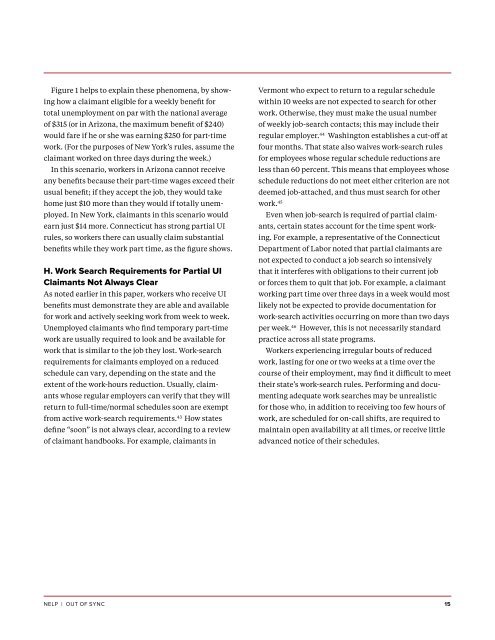Out of Sync
Out-of-Sync-Report
Out-of-Sync-Report
- No tags were found...
Create successful ePaper yourself
Turn your PDF publications into a flip-book with our unique Google optimized e-Paper software.
Figure 1 helps to explain these phenomena, by showinghow a claimant eligible for a weekly benefit fortotal unemployment on par with the national average<strong>of</strong> $315 (or in Arizona, the maximum benefit <strong>of</strong> $240)would fare if he or she was earning $250 for part-timework. (For the purposes <strong>of</strong> New York’s rules, assume theclaimant worked on three days during the week.)In this scenario, workers in Arizona cannot receiveany benefits because their part-time wages exceed theirusual benefit; if they accept the job, they would takehome just $10 more than they would if totally unemployed.In New York, claimants in this scenario wouldearn just $14 more. Connecticut has strong partial UIrules, so workers there can usually claim substantialbenefits while they work part time, as the figure shows.H. Work Search Requirements for Partial UIClaimants Not Always ClearAs noted earlier in this paper, workers who receive UIbenefits must demonstrate they are able and availablefor work and actively seeking work from week to week.Unemployed claimants who find temporary part-timework are usually required to look and be available forwork that is similar to the job they lost. Work-searchrequirements for claimants employed on a reducedschedule can vary, depending on the state and theextent <strong>of</strong> the work-hours reduction. Usually, claimantswhose regular employers can verify that they willreturn to full-time/normal schedules soon are exemptfrom active work-search requirements. 43 How statesdefine “soon” is not always clear, according to a review<strong>of</strong> claimant handbooks. For example, claimants inVermont who expect to return to a regular schedulewithin 10 weeks are not expected to search for otherwork. Otherwise, they must make the usual number<strong>of</strong> weekly job-search contacts; this may include theirregular employer. 44 Washington establishes a cut-<strong>of</strong>f atfour months. That state also waives work-search rulesfor employees whose regular schedule reductions areless than 60 percent. This means that employees whoseschedule reductions do not meet either criterion are notdeemed job-attached, and thus must search for otherwork. 45Even when job-search is required <strong>of</strong> partial claimants,certain states account for the time spent working.For example, a representative <strong>of</strong> the ConnecticutDepartment <strong>of</strong> Labor noted that partial claimants arenot expected to conduct a job search so intensivelythat it interferes with obligations to their current jobor forces them to quit that job. For example, a claimantworking part time over three days in a week would mostlikely not be expected to provide documentation forwork-search activities occurring on more than two daysper week. 46 However, this is not necessarily standardpractice across all state programs.Workers experiencing irregular bouts <strong>of</strong> reducedwork, lasting for one or two weeks at a time over thecourse <strong>of</strong> their employment, may find it difficult to meettheir state’s work-search rules. Performing and documentingadequate work searches may be unrealisticfor those who, in addition to receiving too few hours <strong>of</strong>work, are scheduled for on-call shifts, are required tomaintain open availability at all times, or receive littleadvanced notice <strong>of</strong> their schedules.NELP | OUT OF SYNC 15


